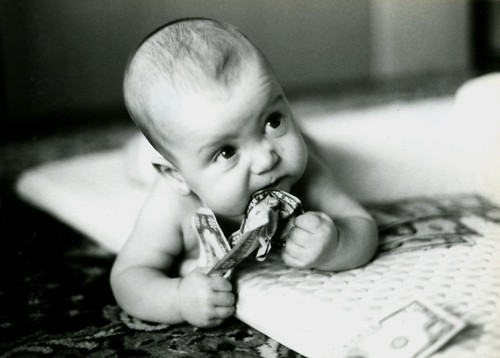- The Festival of Frugality #278 The Pure Peer Pressure Edition is up. All of your friends are reading it. http://bit.ly/aqkn4K #
- RT @princewally: Happy StarWars Day!: princewally's world http://goo.gl/fb/rLWAA #
- Money Hacks Carnival #114 – Hollywood Edition http://bit.ly/dxU86w (via @nerdwallet) #
- I am the #1 google hit for "charisma weee". Awesome. #
Work at Home Scams
The idea of working from home is certainly appealing. You get to set your own hours, sleep in some days, and be there when the kids get home from school. You can be there when the packages get delivered and let the dog out before it’s too late. Who doesn’t see the attraction?
Unfortunately, when something is so enticing, there will always be predators looking to take advantage of the dreams of others. They dangle the “be your own boss” bait and reel in the people who their wishes overrule their judgment.
The ads are hard to resist. “Make $2800 per month without leaving your home!” or “Stuff envelopes in your home for $1 per envelopes.” I cases like these, the old saw tends to hold true: If it sounds too good to be true, it probably is.
Common work-at-home scams include:
Medical Billing
For only $499.99, you can purchase a “business opportunity”. A lot of medical bill is actually done on paper so there is very real market for medical billing and processing. Unfortunately for the respondents to these ads, the vast majority of this market is already taken by large companies with huge marketing budgets. Finding enough customer to generate enough revenue to recover your investment is almost impossible, but you’ll never see that in an ad.
Envelope Stuffing
You answer an ad in the paper, sending $29.95 for a packet that will instruct you in the fine art of stuffing envelopes for $1 each. When you get the information, you find out it is a letter instructing you to place an ad in the papers stating “Stuff Envelopes for $1 Each. $29.95 for Information.” This forces you to become the scammer, just to recover your costs. Bad you.
Assembly or Craft Work
This one actually sounds like a business. You invest in–for example–a sign-making machine for $1500. The selling company promises to buy a quota of signs from you each month. After you buy the equipment and materials you spend countless hours making the product only to find out that either a) the company has disappeared or b) their undefined “Quality Standards” has rejected the work. Nothing is ever up to standards.
That’s not to say there aren’t legitimate opportunities to make money at home. Bob at Christian Personal Finance recently listed 24 legitimate home-based businesses, including blogging, eBay selling, wedding planning, car mechanic, and mobile oil changes.
Are you exploring any home-based business opportunities?
Cheap Drugs – How I Saved $25 in 3 Minutes

- Image by cackhanded via Flickr
Today, I stopped by the grocery store to pick up a couple of prescriptions. I always get the generics, because they are less than half the price of the name-brands, while still being chemically identical. That’s not what I’m talking about, although it did save me about $75 today.
When the pharmacist rang up my medications, the total came up to $35. That just wasn’t right.
Many chain pharmacies have gone to a cheap pricing model for generic drugs. That usually means $4-6 per monthly prescription. Cub Foods doesn’t have that.
So I asked for the price match.
Cub Foods matches prices on generics with whatever large pharmacy is nearby. In this case, they matched Target’s prices, bringing the price from $35 to $10. Instant $25 savings. I just had to wait for them to look up my prescriptions in their match-book.
Pharmacies with cheap generics:
K-Mart offers a 3 month supply for $15.
Target and Wal-Mart both have a 30-day supply for $4.
Publix offers a 14-day prescription for some antibiotics for free. That’s insane! It’s also a heckuva way to get people in the door. “Why don’t you shop for half an hour while I fill your scrip?”
If your pharmacy is anywhere near any of these stores, call and ask if they’ll match the price for generic drugs.
A few tips:
Before you go get your cheap drugs, call ahead and make sure what you need is on the cheap list. Don’t assume.
You won’t be able to use your insurance to buy the cheap generics. The overhead in insurance processing would mean that the pharmacies would be operating at a loss for each prescription. You can’t make that up in volume. Between our copays and deductibles, it’s far cheaper to just pay the generic price without involving the insurance company.
Don’t be afraid of generics. It’s not like Nike. Generics are chemically identical to the name brands. There are two differences: the price and the letter stamped on the side of the pill.
The stores offering cheap drugs are generally bigger stores hoping to use the drugs as a loss leader. Places like Walgreens or CVS make up to 70% of their profits from the pharmacy. They can’t stay open treating that as a loss leader.
How do you save money on prescriptions?
Babies Are Expensive
From the comments here. The discussion is on how much it costs to have a baby. Edited for clarity.
 Babies” width=”270″ height=”200″ />
Babies” width=”270″ height=”200″ />
Actual birthing costs vary. We’ve had three kids over ten years and birthing costs have varied from $250 out of pocket to $8500. Our highest and lowest price births were 20 months apart. The highest price birth involved induced labor with an epidural. For the lowest out-of-pocket price, I added my wife to my policy before the birth, so she was double-covered. If one of your policies is less than ideal and there are multiple policies available, I recommend doing this. It saved us thousands. All told, If things go well, you could slide for as little as $1500 total.
For the highest price birth, we threw ourselves on the mercy of the finance department. They have a charity fund to pay the bills of the less fortunate. We qualified…barely. If you have a medical bill you can’t afford, ask if there is a grant or donation you can apply for. Always ask if there is some way the bill could be lowered.
Breast-feeding beats the heck out of formula, financially, but breast-feeding doesn’t always work. Ignore the boob-nazis who insist you are slowly killing your kid by using formula. I’ve got 3 kids, and each had different feeding issues.
Baby formula runs $19 for a big container at Sam’s Club, or a large percentage of your soul at most other big box stores. Formula alone will pay for your membership in under a month. For a big eater, that’s $20-30 per week. For a normal eater, 2-3 weeks. For planning purposes, assume $100/month in formula costs for the first six months, when food starts coming into play heavily. After that, the formula expense goes down, but not away for at least 6 more months.
Diapers are painful. Not just the smell–though that hurts, too, sometimes–but the expense. I currently have 2 in diapers; one is potty-training. Our monthly costs for diapers, now, are about $75. It was easily twice that when they were younger. Figure at least $100 per month in diapers. Unless your baby has irritation problems, go with cheap diapers. Leak-guard is a joke. If you are relying on leak-guard to keep the contents inside the diaper, you aren’t changing your baby often enough.
I couldn’t begin to guess at how much you’ll spend on baby clothes. I have never bought clothes for our kids. Whatever didn’t come free from friends and family walked into the house of it’s own volition, following my wife home from the store.
Toys are an almost purely voluntary expense. You’ll get as much as the kids needs free, as presents. You’ll go overboard and give the kids 10 times that, without realizing it. Don’t. For the first four to five months, its fingers and toes will be entertaining enough. After that, if there are more than about ten toys, it’s too many; the kid will never get attached to any of them. Keep it small. It’s better for the kids and the budget. Little kids prefer boxes to toys, anyway. Give the kid a shoebox instead of a Leapfrog. Really.
Portraits suck, too. If you have to get them done professionally, get a membership that covers sitting fees, and use coupons. I recommend JC Penney’s. Using judicious coupons and the membership, we get portraits for under $20.
Baby food is probably cheaper to make in a food processor, but you can’t beat the convenience of the little jars. If you watch sales, you can stock up affordably. Mix every meal with some rice or oatmeal mush to stretch it, without making it unhealthy. Depending on your kids, and how much you listen to the “experts”, this is a nonexistent expense before six months. Our kids started eating baby food in their second months, at least a little bit.
Babies are expensive. Don’t doubt that for a second, but ignore the polled averages when it comes to expense. Hand-me-downs, thrift stores, and good sales cut the expense a lot.
How do you save money and value with a baby in the house?